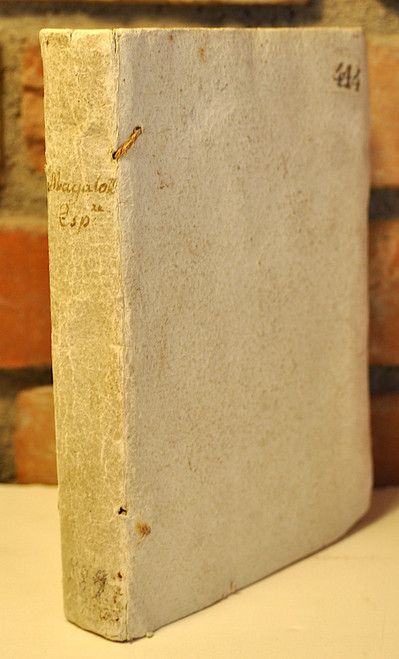Plinii secundi; Plinii secundi Naturalis Historiae libri triginta septum. Nunc demun ex Aldini archetupis pristino suo nitoti accurate restituti: affixa suis losis Sigismundi Gelenii oculatissime viri castigatione: qua ex ipsa egregie cognita vere lectione, vitiatium quod erat pellitur. His accessit traditarum a Plinio rerum index locupletissimus. Apud Hieronymum Scotum, Venetiss (Venice); 1571. Small folio, pp. 22, 422, 128. Printer’s devices include a title vignette showing a Griffen, initials, head and tail pieces. Index has a separate title page with another printer’s device.
The work is complete and bound in an early 20th century full calf in an early French style, raised spine bands with gilt titles and gilt ruled panels. Boards ruled in gilt on front and rear. The binding is tight and clean with minor scuffing. The text has old marginal stains and browning to pages, primarily on the outer margin, some worming at the lower margin of a few pages. Over all a good copy in a very good binding.
PLINY, THE ELDER, (CASIUS PLINIUS SECUNDUS), 23-79 A.D. Plinius Secundus was an Italian naturalist, writer and encyclopedist. He was born in what is now Como, Italy and died near Pompeii, Italy during the eruption of Vesuvius.
Pliny was a foremost authority on science in ancient Europe. He was educated in Rome and after a military career he retired to devote his time to the study of the natural sciences and writing. Of the many works written by Pliny, the only one to be preserved was his great encyclopedia of nature and art in 37 books, the Naturalis Historiae. The first ten books were published in 77 A.D. and the remainder after his death, edited probably by his nephew, Pliny the Younger. In 79 A.D., eager to examine more closely the eruption of Mount Vesuvius that destroyed Herculaneum and Pompeii, he sailed across the bay of Naples to Stabiae, where he was suffocated by the ash and gases from the eruption.
Pliny’s work is the first printed book dealing with natural history, and is an encyclopedia of the ancient world covering many subjects. It was held in high esteem by scholars for over fifteen centuries and became one of the most influential books on science ever written.
Pliny states in the preface that the work contains over 20,000 facts culled from some 200 books. There are 473 authors mentioned: 146 Roman and 327 Greek. While he uses Aristotle as his principle authority, Pliny cites information from sources as he uncovered them, and thus, a vast amount of material preserved in his book which would otherwise have been lost to the world has been preserved.
A careful reading of the work reveals a vast amount of natural history data which is common to us now and presumed to be of modern discovery but which was actually recorded first by Pliny.
The first ten books of Pliny's work were written about 77 A.D. During the next two years, the remainder of the text was being revised and edited, and was left unfinished at the time of Pliny's tragic death It is probable that some material was added when the author's nephew Pliny the Younger (61-113 AD) completed the great work and made it available to the world.
The Naturalis Historiae is a comprehensive work divided into 37 books (or sections) that make it the first encyclopedia of knowledge. Scientific subjects include astronomy, chemistry, geology, mineralogy, botany, husbandry, zoology, geography, anthropology, ethnology, and the history and practice of medicine and art. It was a common source from which early writers of science drew examples.
The final five books contain the ancient Roman view of minerals and geological processes. Pliny provides details on the Roman mineral industry with broad discussions of the mining methods and smelting processes of metals. He discusses the value of various earths for colors and ceramics, and the occurrence and uses of numerous minerals and gems.













